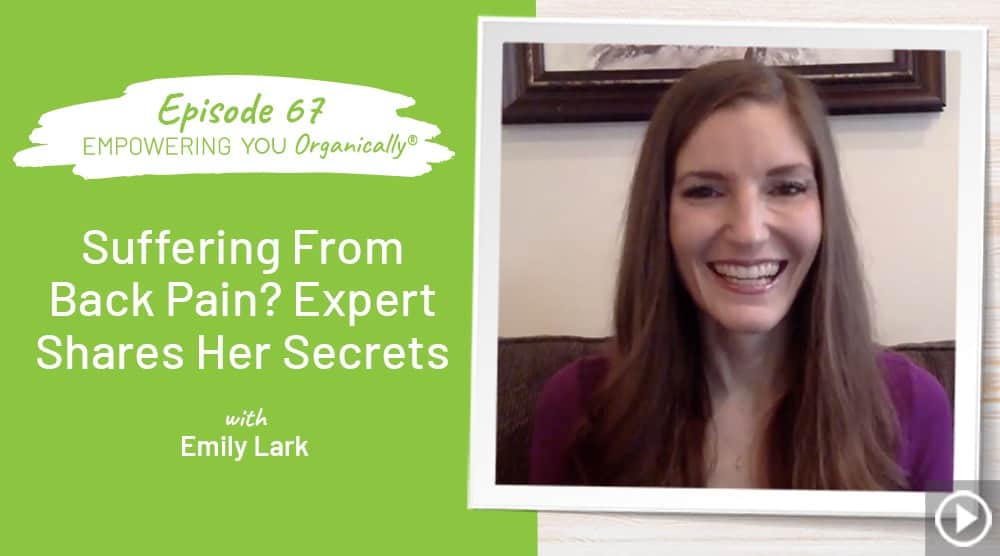Empowering You Organically – Season 8 – Episode 67
Title: Suffering from Back Pain? Leading Expert Shares Her Secrets to Being Pain-Free
Host: Jonathan Hunsaker
Guest: Emily Lark
Description: Back to Life Program and how people listening can get relief from back pain.
Featured Product
- The ultimate support for healthy inflammation levels.
- Pure, powerful, organic fermented turmeric.
- Fermentation maximizes your body’s intake of nutrients.
- Also provides you fermented vitamin D3!
- Supports healthy inflammation levels
* * *
About Emily
Emily Lark is a speaker, author, studio owner, and creator of the internationally bestselling program Back to Life. After living most of her life with debilitating back pain, Emily created a method to naturally heal back pain that has now helped hundreds of thousands of people around the world. Back to Life is so simple that anyone can do it from home in just minutes a day and it has quickly become the #1 healthy back DVD program in the world.
Back Pain Statistics
- Back pain accounts for more than 264 million lost work days in one year—that’s two work days for every full-time worker in the country.
- Experts estimate that up to 80% of the population will experience back pain at some time in their lives
Emily’s one thing that most people are doing wrong when it comes to chronic pain.
- “I think one of the key things that people are missing when it comes to chronic pain, I think the biggest thing that people are missing is the strength-building, too, because if we can strengthen the muscles to support our skeletal system, then they don’t start feeling that pain, the joints have more life to them.”
The worst back pain advice that many doctors are still giving.
- Most of us, when we injure ourselves, when we’re in pain, we think that what we need to do is just kind of rest. But now, we’re really starting to find that movement is actually the fastest route to healing in most cases.
Emily’s Top 3 Stretches to Stop Back Pain.
- Neck and shoulders
- Doorway stretch, where you go into a doorway with your elbows on the side like goalposts, you lean the chest forward, and you hold for just 30 seconds. Then, you can work your elbows up a little bit, you can work them down. But you want to feel that stretch in the front of the chest. I try to tell people to remember to do it just three times a day. Get up for 30 seconds and stretch that out.
- Your core (your abdominal muscles, specifically the ones in the lower abdomen region)
- All you do is sit up really tall, and then you just lift one knee up and pull the belly in. And you lower it down and lift the other one up. That’s going to activate those lower abdominal muscles. You can do a marching movement; you can lift and hold.
- Your spine
- Try to move the spine in all six directions at least once a day. And so, that would be a forward bend, a back bend, side bend to the right, side bend to the left, and then a twist, and a twist.
Stretching Tips
- You want to ease into it, because if you try to push too hard into a stretch, your body actually gives the opposite reaction of tensing up the muscles.
- Start in a stretch where you feel that edge, but you’re not feeling any pain, you’re not feeling horrible amounts of tension. And then using the breath, breathing in and out through the nose, actually has a very calming effect on the nervous system and it actually, if you think of your breath kind of communicating directly with your muscles, that will help the muscles start to release.
- Rather than pushing them into it, try to breathe into those muscles.
- You always want to hold a stretch for at least 30 seconds. That’s kind of like the magic timeframe, where if you hold for 30 seconds, that’s where you’re going to get the most bang for your buck. Anything less than 30 seconds, they’ve shown you don’t actually really increase your flexibility.
Don’t Forget to Warm Up
- If you haven’t moved at all yet in the morning, absolutely, you can go into some gentle morning stretches, but don’t push the body if it’s the first thing you’re doing. If you’ve been moving around throughout your day, your body is kind of warmed up, and then you can go into it a little bit more.
What back pain is really telling us.
- “I think the worst thing that we can do is just try to medicate and numb the pain out. Because clearly, if we’re in pain, our body’s trying to tell us something.” ~Emily
- People often think that it’s our strong muscles that are the ones that are the tight ones. It’s actually the opposite that’s true. The weaker the muscles are, the tighter they get.
Simple daily tips to help with back pain like how to stand, sit and sleep.
- Stacking your posture
- When you’re standing, always try to stand with your feet lined up with your hip bones, with your toes straight forward. Standing with the feet straight forward, and then slightly lifting your arches, you’ll feel the ankles stop rolling together, and the knees stop knocking together.
- From there, we kind of work our way up to the low belly. I always advise people, as much as we can remember, try to draw the low belly in.
- We want the shoulders to draw back right over the hips rather than forward.
- Then, we want to draw the ears back right over the shoulders.
- And a great test for this, to see if you’re standing up as tall as you could be, is to go stand with your back against a wall and try to see if you can get your shoulder blades to touch the wall, the back of your head to touch the wall at the same time, and then here’s the kicker, see if you can get your low ribs to touch the wall at the same time.
* * *
Subscribe to Empowering You Organically
Never miss an episode!
APPLE PODCASTS SPOTIFY GOOGLE PODCASTS
–
Episode 67 – Suffering from Back Pain? Leading Expert Shares Her Secrets to Being Pain-Free





